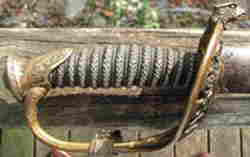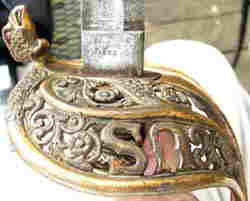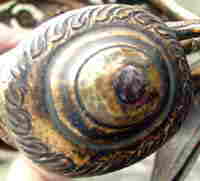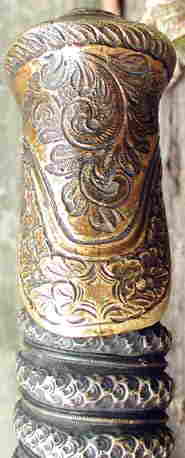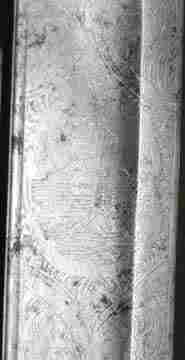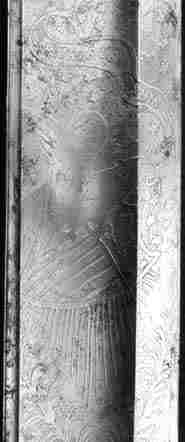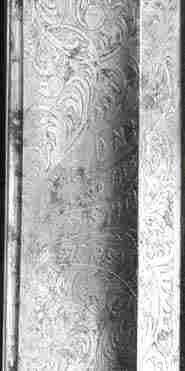|
|
||||
|
(SLIGHTLY USED)
|
||||

|
||||
|
(In Scabbard)
|
||||
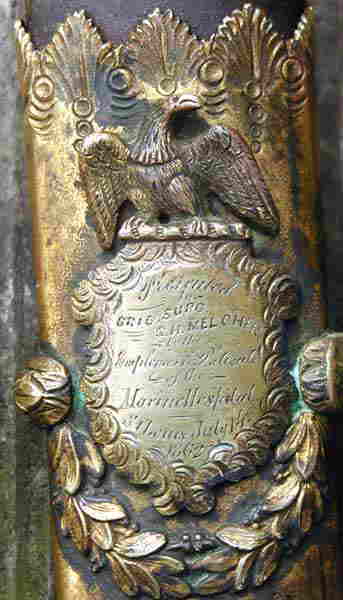
Inscription On Obverse of Middle Scabbard Band
|
-to- BRIG. SURG. S. H. MELCHER -by the- Employees & Patients -of the- Marine Hospital ------------ St. Louis July 14th -1862- |
|||
|
|
||||
|
During part of 1862, Brigade Surgeon S. H. Melcher was in charge
of 3 military hospitals in St. Louis. He was also secretary and
member of the State Medical Army Examining Board. He served as Chief
Medical Officer, District of S. W. Missouri and as Medical
Director of The Army Of The Frontier. He was a veteran of the 5th
Regiment Missouri Volunteers - a three month stint that stretched
out to twice that amount of time with almost equal parts being shared
between his Union regiment, and being "in the hands of the rebels
for more than 3 months in charge of wounded who were left on the
field and in Springfield."
A month later he was in Springfield, MO from where he went to “fight mit Sigel” at the Battle of Carthage on July 5, 1861. On August 2, he took part in the “affair” at Dug Springs and 8 days later participated “historically” in the Battle of Wilson's Creek. By “historic” we are referring to the fact that he has been given credit on an named individual basis as advising Col. Sigel that the 3rd Louisiana coming up the Telegraph Road was actually the then greyclad 1st Iowa. When they were within 10 paces of the gun stilled Sigel line, all hell broke loose resulting in the rout of Sigel's brigade. To Melcher's favor, his statement was corroborated by several unnamed skirmishers.
|
||||
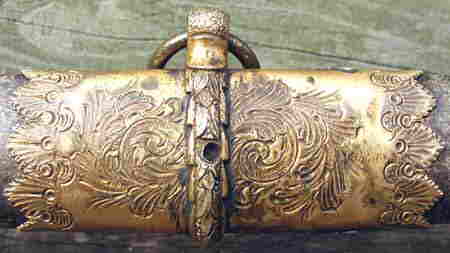
Reverse Of Middle Scabbard Band |
||||
|
A week after his enlistment on May 7, 1861 in the 5th at the age
of 32, he was on an expedition to Potosi, De Soto and Victoria,
Missouri capturing secessionists, their horses and, as noted by
soon to be General Nathaniel Lyon, a secessionist flag.
|
||||
|
His initial actions at Wilson's Creek were more those of a scout
than a doctor. He also tried to re-direct Sigel's artillery as it
was, in his own words, “creating a stampede but doing little, if
any, damage to life or limb.” Quite a comment, for a doctor.
|
||||
|
Later that day, the Federals captured a Doctor Smith, a surgeon
in Confederate General Rains' division. At Melcher's instigation
he was released and the two doctors returned to the battlefield
together. This proved propitious as the Confederates turned over
the slain General Lyon's body to Melcher which he, along with a
Confederate honor guard, took to Springfield where he turned the
body over to Maj. General J. M. Schofield. Dr. Melcher then attended
to the wounded at Springfield. After the Federal withdrawal from
Springfield, the Confederates took over the hospital and Dr. Melcher.
He remained there for over 3 months caring for the wounded before
being allowed to return to St. Louis. Strangely enough, I have not
been able to find any evidence that Dr. Melcher was ever officially
declared to be a prisoner or that he was paroled or exchanged.
|
||||
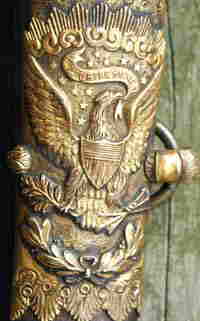
Obverse of Top Scabbard Band
|
||||
|
Obviously, the presentation date on the sword indicates that he
was involved in some capacity with the Marine Hospital at St. Louis
as of July 14, 1862. However, we have not found specific orders
or information as to the exact dates that he was in charge of the
3 hospitals. Pension paper notes indicate that he was Chief Medical
Officer- District of S. W. Missouri from approximately June of 62
to January of 63. Another application states he was Medical Director
of the Army of The Frontier during the winter of 1862 - 1863. That
notation also carried the remark that “He shouldered a rifle.” It
was made by Gen. E. B. Brown. These assignments might have been
concurrent with other duties as the the next official records we
have on Doctor Melcher indicates that he was Colonel of the Washington
County Militia with headquarters at Potosi, Missouri. These records
are dated September 9, 15 and 29. One is a report by Melcher of
a skirmish on Strother's Fork of Black River. Another is a letter
involving dealing with a civilian and the third, dated September
29, 1862 contains instructions regarding disbanding of the Washington
County Militia.
|
||||

Reverse Of Top Scabbard Band
|
||||
|
In January of 1863, Brigade Surgeon Melcher is in charge of the
Post Hospital at Springfield, Mo. Another battle is brewing. General
Marmaduke is preparing to attack the town. On January 7, Doctor
Melcher went through the hospitals calling for volunteers to defend
the town. He got about 300 men, organized them into companies of
50 men each and placed them under the command of nurses, stewards
and disabled commissioned officers. They were marched to the arsenal
and furnished muskets and ammunition. These people became part of
the "quinine brigade" and provided heroic and valuable service during
the battle. Melcher also advised General E. B. Brown as to the availability
of three dismounted old iron guns, two 12-pounders and one 6-pounder
and got permission to prepare the guns to be placed in Fort No.
4 where they were put under the charge of nine volunteer artillery
men who were sick and enfeebled. Two attempts to take Fort No. 4
were turned back by the heavy and intense fire of the soldiers and
convalescents. The next morning it was discovered that Marmaduke
had withdrawn. The Battle of Springfield was over.
|
||||
|
|
||||
|
||||
|
Dr. Melcher and the "Quinine Brigade" were lauded in the reports
of the battle. This was the battle where Surgeon Melcher "shouldered
a rifle". Mention of this was made by Gen. E. B. Brown in Melcher's
pension papers. It was a battle that effected Melcher for the rest
of his life as on the night of January 8, 1863 a "Rebel" shell exploded
as it passed over his head causing him to dismount due to a momentary
dizziness. He stated that "It seemed like a cord was tight about
my brain with a terrible headache." He was first treated 3 days
later. The constricted feeling about his brain and headaches continued
the rest of his life and his sight starts to fail after discharge.
General E. B. Brown was also grievously wounded by a treacherous
shot from a "secesh" residence.
|
||||
|
The sword we are looking at was, in all likelihood, carried by Melcher
before, during and after the Battle of Springfield. It is a used
sword. The scabbard is somewhat weather beaten. Some screws are
missing and the blade has been pitted heavily at and near the point.
The rest of the blade is spotted and stained. It was so bad that
I cleaned it - carefully. It was just too bad to leave as is. The
scabbard must have gathered water to have caused the long term damage
to the blade. Melcher was a busy and active man. He took it on himself
to be involved in all aspects of military duty. In 43-1/2 months,
he took no leave and did not miss a day's duty due to sickness.
I can forgive him for not attending to his sword more than he did.
That's OK. I will replace the missing screws and will also treat
the scabbard to some careful restoration. I will do it in his honor.
|
||||
|
|
||||

Overall Obverse View Of Brigade Surgeon S. H. Melcher's Presentation Sword Unsheathed
|
||||
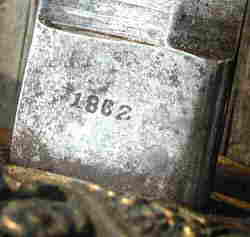
Obverse Ricasso Stamped "1862"
|

Reverse Ricasso Marked "COLLINS & CO" In An Arch Over "HARTFORD" Over "CONN"
|
|||
|
On May 25, 1863, Melcher resigns his medical commission. On the
same date, he is appointed as a Lieut. Colonel in the Sixth Cavalry
Missouri State Militia with the effective date being May 28 "by
virtue of commission from his excellency H. R, Gamble, Gov. of Mo."
On July 10 he was named Assistant Inspector-General to the staff
of Maj. Gen. Schofield. On October 1, 1864, he becomes Acting Aid-de-Camp
to General Pleasonton during Prices Raid. He is very active throughout
the area Southwest and West of St. Louis. On November 1, 1864 Major
General Pleasonton praises Melcher, along with others, as being
"conspicuous for gallantry and fidelity."
|
||||
|
|
||||

Head On View Of Eagle Head Quillon
|
||||
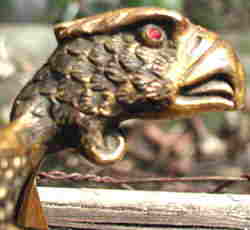
Obverse Of Quillon
|

Reverse Of Quillon
|
|||
|
On November 2, 1864, Melcher assumes command of Jefferson City,
Mo. He is much involved in rounding up demoralized stragglers, deprecations
in the area, reporting rebel movements and arranging transportation
for troops, stragglers, convalescents and material to St. Louis.
In response to one message requesting "that all artillery belonging
to Smith's command to be sent to St. Louis", he replies "that except
for a few thieves and plunderers, all of Smith's command; horse,
foot and artillery has been sent." The local militia in his sub-district
also " pass themselves as bushwhackers, and rob, burn and kill,
etc." He has now made several requests for leave or to be sent back
to St. Louis as to attend to "neglected personal business" (his
father is dying). He is not happy. His messages get more and more
critical of the 16th and 17th Corps and their officers. His headaches
continue and seeks treatment for them.
|
||||
|
|
||||
|
||||
|
On November 25, 1864, Melcher is relieved of duty at Jefferson City,
Mo and ordered to report to his regiment without delay. He requests
a delay so as to finish up pending court martials at Jefferson City.
Col. Melcher cannot break his own mold. He finally resigns and is
discharged on December 22, 1864. This does not prevent Melcher from
sending a dispatch to Col. J. H. Baker, Provost-Marshal-General
at Memphis Tenn., on January 17, 1865 as to rebels "Dick Berryman"
and a young man from Farmington Mo., "by name of Clary" and telling
him of rebel movements from information that he picked up in Crittenden
County, Arkansas. Old habits are hard to break.
|
||||
|
|
||||

Obverse of Scabbard Drag
|

Reverse of Scabbard Drag
|
|||
|
In May of 1865, he is working as an agent for The Freedman's Bureau
in La Grange, Tenn. He is having difficulty with his vision. At
ten feet he cannot tell a white man from a black man. He is there
until 1872 when he moves to St. Louis. His first wife dies at St.
Louis in 1880. They have one child who was born in 1857, Around
or before 1875 he moves to Chicago, remarries in May of 1882 at
Laport, Indiana and moves, in 1883, to Crow Lake, Dakota Territory,
where his second child is born in 1884 when Melcher is 56 years
old. The children are born 27 years apart. His sight is all but
gone, he cannot leave the house without a guide. In 1909 he moves
back to Illinois and resides in Chicago from 1910 until 1915 when
he dies of senility at the age of 86 years, 9 months and 1 day.
Death certificate states that an extended attack of hiccups was
a contributory factor.
|
||||
|
|
||||

"IRON PROOF" On Top Of Blade Back (forte) Near Hilt
|
||||
|
||||
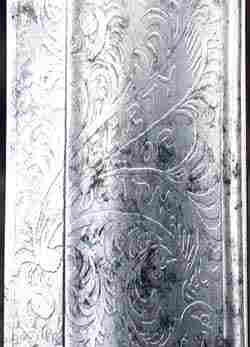
"LIBERTY OR DEATH" - Reverse
|

U. S. (Entwined) - Reverse
|
|||
|
|
||||
| The
following information sources were utilized for this posting:
|
||||
| •
Pages 407 & 408 - “THE UNION CAUSE IN ST. LOUIS IN 1861.” By
Robert J. Rombauer. Pub. 1909 (Fifth Regiment Infantry, Missouri
Volunteers - Asst. Surgeon F&S).
|
||||
| •
Pages 1307, 1324 & 1343 - “THE COMPENDIUM OF THE WAR OF THE
REBELLION” Vol. II by Dyer. Pub. 1908 (Regimental Histories - 5th
Regiment Infantry (3 Months), 6th Regiment State Missouri Cavalry,
Washington County Militia.
|
||||
| •
Page 247 - “REBELLION IN MISSOURI: 1861” by Hans Christian Adamson.
Pub. 1961
|
||||
| •
Pages 72, 87, 88 & 92 - “THE BATTLE OF WILSON'S CREEK” By Edwin
C. Bearss - Fourth Edition. Pub. 1992
|
||||
| •
Pages 31, 42, 46, 47 & 48 (Melcher's account of battle) and
pages 96 through 104 (“Disposition Of The Body Of General Lyon”,
in which Dr. Melcher played a prominent part) - “AN ACCOUNT OF THE
BATTLE OF WILSON'S CREEK OR OAK HILLS” by Holcombe and Adams. Pub.
1883. Republished 1961. Reprinted 1985.
|
||||
| •
Pages 22 through 29 “The Battle Of Springfield” from “AN ILLUSTRATED
HISTORY OF THE CIVIL WAR IN SPRINGFIELD, MO., 1861-1865" By Robert
Neuman, Springfield, Missouri. Published 1975 (by author).
|
||||
| •
48 pages from the Official Records in which Samuel H. Melcher is
mentioned as a third party or are copies of correspondence either
written by him or sent to him.
|
||||
| •
44 pages of his pension applications (A lot of his former associates
attest to Melcher's military service plus Melcher's own statements).
|
||||
| •
16 pages of Melcher's military records - Muster rolls, etc.
|
||||
|
|
||||
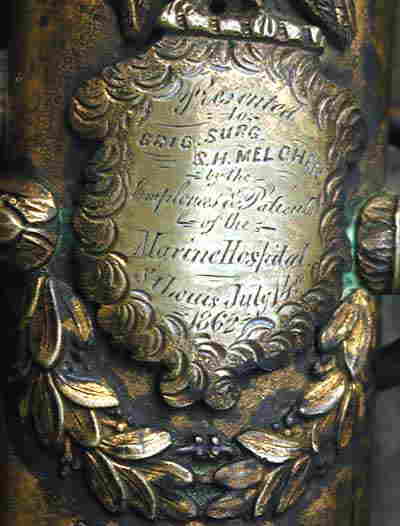
Inscription On Obverse of Middle Scabbard Band (Enlargement)
|
||||
|
|
||||
|
This sword is my most recent acquisition. It delayed the posting
of "The Collector's Item of The Week" by a full week while I searched
the Official Records and the various books that I have that contained
information on the affairs, actions, skirmishes and battles in Missouri.
Also all pension and military records were sorted by date so a time
line could be developed on Brigade Surgeon / Lieutenant Colonel
Samuel Henry Melcher. This information was then used for this write-up.
It was a small world here in Missouri during the Civil War. I found
that I had another identified sword that later belonged to one of
his wounded patients from Springfield in 1861. Also, I have a lot
of items that belonged to a 1st Iowa cavalry man who was in Jefferson
City, Missouri when Melcher was in command in 1864. I will have
to go through that troopers letters to see if any mention of Melcher
is in them. I have a feeling that this is the nucleus that will
bring a close relationship to numerous items now in my collection
and initiate an ongoing search for additional items. Can anybody
spare a dime? I'm going to need it. <G>
|
||||
|
I guess the biggest coincidence of all, for me, is that the Marine
Hospital in St. Louis was moved out to Kirkwood, MO in the
late 1930's or early 40's. It was later "sold" or given to a Catholic
hospital group. It is now St. Joseph's, a mile or so from my house.
I have spent some time there and that's where my Doctor's office
is. In a way, the sword is just about back to where Dr. Melcher
received it. Dr. Melcher also was quite active in this area in October
of 1864 as it was expected that Price's Army would pass through
Kirkwood to capture St. Louis, so a primary defense line was established
in Kirkwood at the Meramec River. Perhaps concerned about this defense
line, Price turned and headed west towards Jefferson City. The "Battle
of Kirkwood" went with him.
|
||||
|
That closes up this posting. My thanks as always to my son and webmaster,
Reed Radcliffe, for getting this on the page. I hope it does not
take him a week to handle it as it did me.
|
||||
| Dave
Radcliffe Kirkwood, Missouri
|
||||
